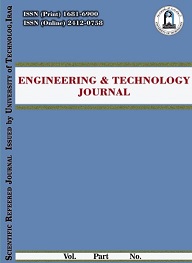Abstract
ABSTRACT
Gypseous soils as any other soils deform under loading, this deformation differs
greatly between its dry state and its soaked state. This deformation also differs when
the loading is applied with eccentricity.
An experimental work was conducted on a square footing model (100 mm ´ 100
mm) above gypseous soil 450 mm thick. Loading was applied at the center of the
footing (e/B = 0) and at an eccentricity of (e/B = 0.05, 0.1, 0.15, 0.2) for its dry state
and its soaked state. Settlement was obtained at the center and at the base soil of the
footing for each state.
The data obtained was normalized and a proposed surface was obtained for each
of the two states (dry and soaked) and at two places (center and edge). Four proposed
equations were obtained represented four cases of research i) Dry center, ii) Dry edge,
iii) Soaked center, and iv) Soaked edge. The four equations showed very good
agreement with the data obtained from the experiment.
Artificial Neural Network model was also used to obtain a neural network
representing the proposed surface for the abovementioned four cases and also a very
good agreement was obtained.
It is concluded that a proposed surface for the central and eccentric loading on
square footing for gypseous soil showed a good agreement with the experimental data
and therefore may be used for settlement prediction
Gypseous soils as any other soils deform under loading, this deformation differs
greatly between its dry state and its soaked state. This deformation also differs when
the loading is applied with eccentricity.
An experimental work was conducted on a square footing model (100 mm ´ 100
mm) above gypseous soil 450 mm thick. Loading was applied at the center of the
footing (e/B = 0) and at an eccentricity of (e/B = 0.05, 0.1, 0.15, 0.2) for its dry state
and its soaked state. Settlement was obtained at the center and at the base soil of the
footing for each state.
The data obtained was normalized and a proposed surface was obtained for each
of the two states (dry and soaked) and at two places (center and edge). Four proposed
equations were obtained represented four cases of research i) Dry center, ii) Dry edge,
iii) Soaked center, and iv) Soaked edge. The four equations showed very good
agreement with the data obtained from the experiment.
Artificial Neural Network model was also used to obtain a neural network
representing the proposed surface for the abovementioned four cases and also a very
good agreement was obtained.
It is concluded that a proposed surface for the central and eccentric loading on
square footing for gypseous soil showed a good agreement with the experimental data
and therefore may be used for settlement prediction
